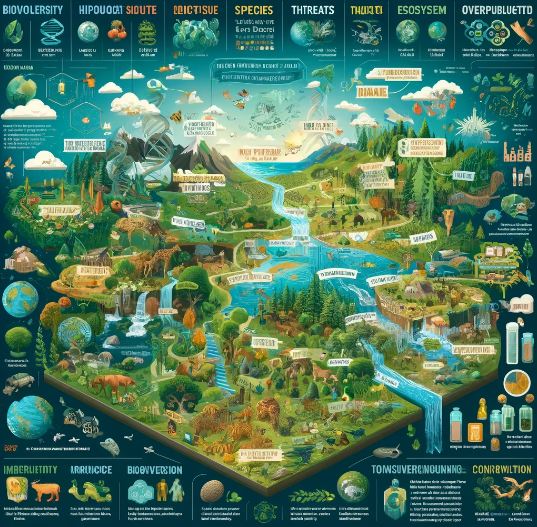Biodiversity and Its Importance
Biodiversity, short for “biological diversity,” refers to the variety of life forms on Earth. It encompasses all living organisms, including plants, animals, fungi, and microorganisms, as well as the ecosystems they form and the genetic diversity within species. Biodiversity is not limited to a single area or ecosystem; it spans from the deepest oceans to the highest mountains and from dense tropical forests to arid deserts. It is a critical component of the Earth’s life-support system, providing invaluable ecological, economic, cultural, and social benefits.
Types of Biodiversity
Biodiversity can be categorized into three main types:
- Genetic Diversity:
This refers to the variation of genes within a species. Genetic diversity is crucial for the survival and adaptability of species. It enables populations to adapt to changing environments, resist diseases, and maintain overall resilience. For example, the genetic variation in crop plants is essential for food security, as it allows the development of new varieties that can withstand pests, diseases, and climate change. - Species Diversity:
This refers to the variety of species within a specific region or ecosystem. It includes the richness (number of species) and evenness (distribution of individuals among species). Species diversity contributes to ecosystem stability, as different species perform various roles in maintaining the ecological balance. - Ecosystem Diversity:
This refers to the variety of ecosystems within a region or the entire planet. Ecosystems, such as forests, wetlands, grasslands, and coral reefs, support a wide range of organisms and provide essential services like climate regulation, water purification, and nutrient cycling.
Importance of Biodiversity
Biodiversity is vital for the well-being of the planet and all its inhabitants. Its significance can be understood through the following points:
1. Ecological Importance
Biodiversity plays a fundamental role in maintaining ecosystem services, which are essential for the survival of all life forms. These services include:
- Pollination: Bees, butterflies, birds, and other pollinators are crucial for the reproduction of many plants, including crops that sustain human populations.
- Nutrient Cycling: Decomposers like fungi and bacteria break down organic matter, recycling nutrients that are vital for plant growth.
- Water Purification: Wetlands and forests filter pollutants from water, ensuring clean water for humans and wildlife.
- Climate Regulation: Forests act as carbon sinks, absorbing carbon dioxide and mitigating the effects of climate change.
2. Economic Value
Biodiversity contributes significantly to the global economy. Many industries depend directly on natural resources derived from biodiversity:
- Agriculture: Biodiversity is the foundation of agriculture, providing genetic material for crop improvement and livestock breeding. Wild relatives of crops are sources of genes for pest resistance, drought tolerance, and higher yields.
- Medicine: Many life-saving drugs are derived from plants, animals, and microorganisms. For example, aspirin originates from willow trees, and cancer treatments like Taxol are derived from yew trees.
- Tourism: Ecotourism and wildlife tourism generate significant revenue for countries, creating jobs and supporting local economies.
3. Cultural and Aesthetic Value
Biodiversity has immense cultural and aesthetic significance. Many cultures are deeply connected to their natural surroundings, drawing inspiration from the diversity of life. Sacred groves, rivers, and animals hold spiritual value in various traditions. Additionally, nature’s beauty provides psychological benefits, fostering a sense of peace and well-being.
4. Scientific and Educational Value
Biodiversity serves as a vast reservoir for scientific research and education. It helps scientists understand the processes of evolution, ecological interactions, and environmental changes. For instance, studying the genetic makeup of diverse species has led to groundbreaking discoveries in genetics and biotechnology.
5. Resilience to Environmental Changes
Ecosystems with high biodiversity are more resilient to environmental changes and disturbances. They can better withstand events like droughts, floods, and invasive species, ensuring the stability of ecosystem services.
Threats to Biodiversity
Despite its immense value, biodiversity is under severe threat due to human activities and natural factors. Some of the major threats include:
- Habitat Loss and Fragmentation:
Urbanization, deforestation, and agricultural expansion are leading to the destruction and fragmentation of habitats, making it difficult for species to survive and reproduce. - Climate Change:
Rising temperatures, changing rainfall patterns, and extreme weather events are altering ecosystems and forcing species to migrate or face extinction. - Pollution:
Air, water, and soil pollution harm ecosystems and species. For example, plastic pollution in oceans endangers marine life, while chemical pollutants disrupt food chains. - Overexploitation:
Overfishing, hunting, and illegal wildlife trade have led to the decline of many species, pushing some to the brink of extinction. - Invasive Species:
Non-native species introduced to new environments often outcompete native species, disrupting ecosystems and reducing biodiversity.
Conservation of Biodiversity
Given the critical importance of biodiversity, conservation efforts are essential. Conservation can be achieved through various approaches:
1. In-Situ Conservation
This involves protecting species in their natural habitats. Protected areas like national parks, wildlife sanctuaries, and biosphere reserves play a key role in conserving ecosystems and their inhabitants.
2. Ex-Situ Conservation
This involves conserving species outside their natural habitats. Methods include seed banks, botanical gardens, zoos, and aquariums. For example, seed banks preserve genetic material for future use in agriculture and restoration.
3. Community Involvement
Local communities play a vital role in biodiversity conservation. Initiatives like joint forest management and eco-development programs empower communities to protect their natural resources.
4. Legislation and Policies
Governments and international organizations have implemented laws and agreements to protect biodiversity. Examples include the Convention on Biological Diversity (CBD), the Ramsar Convention on Wetlands, and the Wildlife Protection Act in India.
5. Sustainable Practices
Adopting sustainable practices in agriculture, forestry, fishing, and urban development can reduce the pressure on ecosystems and promote biodiversity conservation.
Biodiversity in India
India is one of the world’s 17 megadiverse countries, home to a wide range of ecosystems, including the Himalayas, Western Ghats, Indo-Gangetic plains, and Sundarbans. It hosts about 8% of the world’s biodiversity, including iconic species like tigers, elephants, and rhinoceroses. However, India faces significant challenges in conserving its biodiversity due to population pressure, habitat loss, and climate change.
Efforts like Project Tiger, Project Elephant, and the establishment of biosphere reserves demonstrate India’s commitment to biodiversity conservation. The National Biodiversity Action Plan and the Biological Diversity Act also provide a framework for sustainable management of resources.
Conclusion
Biodiversity is the foundation of life on Earth, supporting ecosystems, economies, and cultures. Its loss poses a significant threat to the planet’s stability and human well-being. Therefore, urgent action is needed to address the threats to biodiversity and promote conservation. By fostering a sense of responsibility and adopting sustainable practices, humanity can ensure the protection of biodiversity for future generations. Protecting biodiversity is not just an ecological necessity but also a moral obligation to safeguard the intricate web of life that sustains us all.




